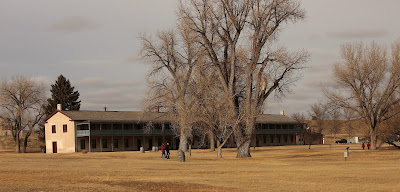Christmas on the Frontier:
At the confluence of the Laramie and North Platte Rivers in southeast Wyoming one finds Fort Laramie. Established in 1834 as a trading post named Fort William by Robert Campbell and William Sublette. The original fortification made with cottonwood logs was only 100 feet by 80 feet with 15 foot walls.
In 1834 the fur trade was on the decline and Campbell and Sublette being the entrepreneurs realized their future was in trading with the Native Americans for buffalo robes. A virtual monopoly was enjoyed until 1841 when a competitor establishment of Fort Platte one mile away. This competition spurred Fort William to be expanded as an adobe structure and then renamed Fort John.
Here the Lakota Sioux traded buffalo robes for manufactured goods. Each Spring new stocks of trade goods would arrive and then in the fall the buffalo robes would be shipped back east. Eventually the herds of buffalo declined and the trade with pioneers traveling west filled the trade gap.
In 1849, the U.S. Army offered to purchase Fort John as part of a plan to establish a military presence along the emigrant trails. The sale was agreed to and on June 28, 1849 Fort John was renamed Fort Laramie. The Army quickly constructed new buildings for stables, officers' and soldiers' quarters, a bakery, a guardhouse, and a powder magazine to house and support the fort garrison.
Fort Laramie soon established itself as a hub of activity for westward expansion. It was the principal military outpost of the Northern Plains. Here emigrants passed as they moved west, the Pony Express, Stage Lines and the transcontinental telegraph all passed through the post.
Fort Laramie also was the location for many treaty negotiations with the Native American Nations, such as the Horse Creek Treaty of 1851 and the still controversial and contested Treaty of 1868.
With the ever increasing numbers of emigrants the relationship with the Native Americans became strained. The number of conflicts increased and military campaigns were launched from Fort Laramie. As the Indian Wars came to a close, Fort Laramie became less important. The post was abandoned and was eventually sold a public auction in 1890. Time took it’s toll on Fort Laramie until 1938 when Fort Laramie became part of the National Park Service.
We arrived at Fort Laramie a little before 1:00pm and made a quick visit to the Visitors Center to get our NPS Passport Stamp. Then we were off to the Calvarymen’s Quarters as there was a hand bell choir performing. Most enjoyable to listen to the bells play Christmas pieces. It was the first time I had ever seen hand chimes. The audience was comprised of mostly local folks and it was nice to see a great turnout.
Next we went outside to see a presentation by a local Pony Express group. It is always good to see these types of groups keeping our history alive. The Pony Express had a rather short lived history of only about 18 months. Yet, during that time mail was delivered from St. Joseph, Missouri to Sacramento in about 10 days. It was the advent of the transcontinental telegraph which brought and end to the Pony Express. These riders demonstrated an exchange of the mochila (the mail pouch).
We then went and got The Boys (our Malamutes) for a walk about the Fort. Dog are allowed at this National Historic Site as long as they are on a leash. (Not in buildings)
The weather forecast was for snow so we wanted to get on the road. As we were leaving we noticed the herd of horses and mules near the roadway so we pulled over for some photos. While there a NPS employee came by with some feed for them. We learned this is a location where the pack horses from Rocky Mountain Nation Park are wintered. It is also a place for retired pack animals to live out their lives. Well done NPS well done.




















